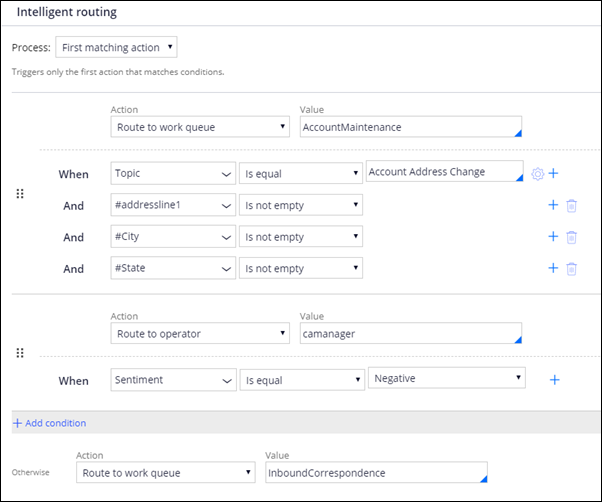
Email routing in customer service
Overview
Pega Email Bot can detect the topic or sentiment of an email and route the email to the appropriate operator or queue. Intelligent routing allows the customer service team to process large volumes of email efficiently and quickly.
Pega Email Bot uses natural language processing (NLP) to analyze the content of an email and do the following:
- Identify the topic – Topics are pre-defined categories that are used to route incoming email to provide an appropriate response. For example, a customer sends an email requesting an address change. The topic is identified and associated with the Account Address Change case.
- Identify sentiment – The overall sentiment of the email: positive, neutral, negative.
- Identify entities - Entities are key information in the email content, such as an account number or email address. Pega Email Bot can identify information in the email subject and body. It can also scan attachments, including images, using optical character recognition (OCR).
- Route email to a queue or operator – Based on the detected topic, sentiment, or entities, the email is routed to a queue or operator.
You configure keywords and routing rules in the email channel
Keywords and text analysis
For each service case, the administrator configures the keywords used for text analysis. The keywords are used to identify the topic in an inbound email and associate the email with a suggested reply or a service case. For example, a disputed credit charge is associated with the Disputed Charge case; a change of address is associated with the Account Address Change case. This association is made by comparing the email content with keywords that you configure for each case type.
You configure keywords in the email channel. You must configure keywords for each service case.
For this training, in the Pega Customer Service application, we have created an email channel called MySupport. The email bot associated with this channel is configured with five service cases. The email bot’s text analyzer is seeded with keywords that can help the bot identify the email topic and associate it with a service case.
Intelligent routing rules
Routing rules use the result of text analysis to route mail to a queue or operator. You define the set of conditions that must be met for Pega Email Bot to invoke the routing action. Conditions can include the identified topic (for example, address change), whether an entity exists (for example, the email content contains the new address), and the sentiment of the email (positive, negative, neutral).
A routing rule can have multiple conditions that must be true before it takes a routing action. If no conditions are met, then the “otherwise” action is taken – such as routing all emails to the Inbound Correspondence queue.
In the routing rule, you can also set a confidence threshold for topic detection. For example, given the text analysis of the email content, there is an 80% probability that the email is an address change request. The text analytics model becomes more accurate as it processes more emails. The model is configured in the Prediction Studio by a data scientist.
If you are having problems with your training, please review the Pega Academy Support FAQs.
Want to help us improve this content?


